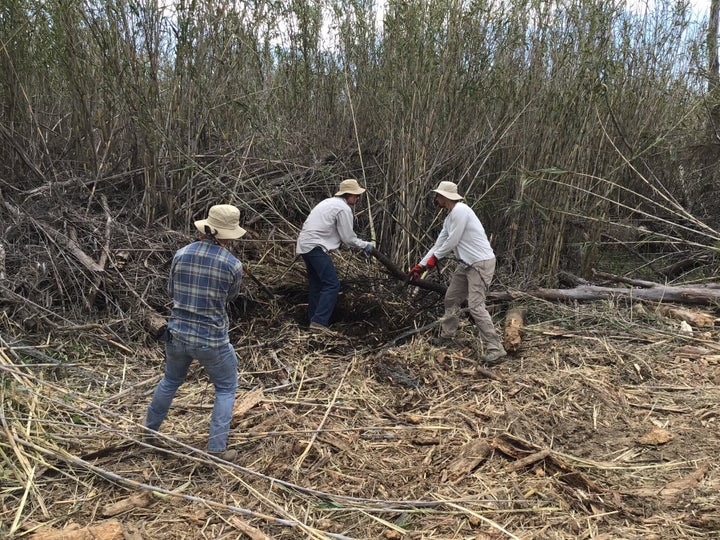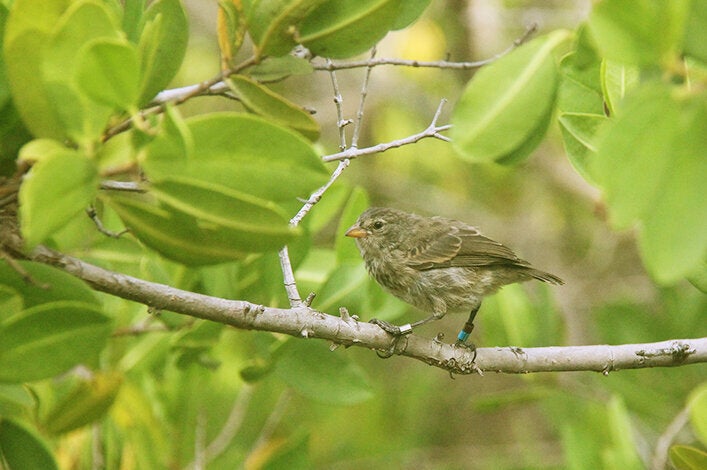As the clouds dumped rain across Southern California’s Santa Clara River region, research biologist Tom Dudley watched from his house and worried.
Before COVID-19 hit, he and his team would be out working along a stretch of the Santa Clara River in Ventura County to control the spread of the invasive giant reed and make way for native cottonwood or willow trees. The bamboo-like weed pushes out endangered birds and acts like fuel for wildfires raging across the landscape.
But for the last six weeks, with invasive management efforts sidelined or downsized because of stay-at-home mandates, the work has stalled, giving unwanted species like the fast-growing reed an opportunity to invade.
And they’re taking it.
“In California, when you get rain, that’s when all the plants start growing, so the weeds are really germinating heavily,” said Dudley, who leads restoration projects under the Marine Science Institute at the University of California, Santa Barbara. “Once you get these nonnatives in there, and they establish, then it can be a whole process of a couple of years trying to get them knocked back before you can plant the native stuff.”

Around the world, many conservation, eradication and control efforts have been affected by the coronavirus. While people in the field understand the importance of flattening the curve and keeping people safe, they also share a deep concern about what hitting the pause button means for their projects and the environment.
Inaction gives nonnative species more freedom to encroach upon areas where they’re not wanted and devour native plant and animal species. The pandemic could set research and control work back years. Lost data can impact scientists’ understanding of ecosystems and how to protect them, while an inability to keep invasive species at bay puts protected species at risk. This is happening at a time when invasions have been on the rise partly due to globalization and a changing climate, which can weaken a natural habitat’s ability to fend off invaders.
“It highlights how fragile everything really is. That, at a global scale, there is a huge number of species across the spectrum that have now become dependent on regular human intervention to keep them hanging on,” said Francesca Cunninghame, an ornithologist and leader of a Charles Darwin Foundation project to protect the critically endangered mangrove finch in the Galápagos. “[The COVID-19] situation, I think, really highlights that and the consequences if the humans doing that work are unable to get to those sites.”

A lack of work on these projects doesn’t just throw off the balance of wildlife. For the giant reed work, for example, there are other critical implications, like water conservation and wildfire prevention. The giant reed, or arundo, is a thirsty plant, so it’s in the surrounding communities’ best interests to keep the weed out to help conserve the precious commodity in the drought-prone region. It also lights up like a Christmas tree.
“It turns river bottoms essentially into wicks for fire to spread across,” Dudley said. “So, it turns from barriers for fire movement into pathways for fire movement.”
With the summer fast approaching, California has the unenviable task of simultaneously managing both wildfires and a pandemic.The Santa Clara River restoration work — funded in part with more than $4 million from the California Natural Resources Agency — has been going for the past 10 years. They currently work in a 600-acre area and have restored about 400 acres so far, with help from The Nature Conservancy and Friends of the Santa Clara River.
Field work restrictions have recently been eased by the university. However, only one person at a time, instead of four or five, can go out to spray herbicide, Dudley said, and contractors that help remove large sections of the weed haven’t been given a greenlight.
“If this continues through the summer … then it actually becomes more problematic,” he said. “Because then you have weeds coming into stature, where they are two meters tall or so, and you have to essentially start from scratch. We are just crossing our fingers we’ll be able to move on this before we get into the summer.”
Time is sensitive, too, for Elizabeth “Biz” Bell. The senior ecologist with Wildlife Management International Limited, a New Zealand-based consultancy and research firm, manages conservation and invasive control efforts around the world. Several of her projects have been cancelled or pushed back a year due to travel and government restrictions.
She has been waiting to find out if her project with the black petrel — a seabird classified as a vulnerable species — on Great Barrier Island can go forward when New Zealand eases its lockdown from current level three to a less strict level two. If approved by the government, the team would be allowed to work with social distancing measures in place.

For the last 24 years, Bell and her team have made the annual trip to the island ― which lies 62 miles northeast of the city of Auckland ― to survey and monitor the birds. A team contracted by New Zealand’s Department of Conservation set traps to capture feral cats, the birds’ predator, before the breeding season last year to protect adult petrels. But new chicks — which start fledging the first or second week of May — sit vulnerable because traps aren’t being maintained.
Missing the chicks before they leave the island would also leave a hole in her research. “If you miss that, your data gets a bit shaky, even after 24 years,” Bell said. “It’s frustrating. We are frantically trying to get back up there so we can check this year off.”
After four weeks on Isabela Island in the Galápagos, Cunninghame and her team were called back by the Ecuadorian government in March. That meant the finch chicks — also fledging around this time — would be left defenseless against the black rat and parasitic larvae from a fly known as Philornis downsi. With teams gone, trappings won’t be maintained and an insecticide to kill the larvae won’t be injected into the nests perched high up on top of the mangroves. Fewer than 20 breeding pairs remain.
“[COVID-19] has probably resulted in close to or zero breeding success,” said Cunninghame, who is quarantined in an Auckland, New Zealand, hotel with her husband and 3-year-old son after arriving from Ecuador. “It’s disastrous,” she added.
Losing a species like the finch doesn’t just rob the planet of its natural beauty. The unprecedented loss of plants and animals is threatening its biodiversity, which is crucial to maintaining everything from food security to clean water to health.
An inability to maintain certain projects may also increase the risk of zoonotic diseases, which some invasive species carry, research has shown. Extended breaks in monitoring could allow a disease to go unnoticed. And disrupting projects that keep disease-ridden invasives away from other species could add to the risk.

Not all work has been affected, as some governments consider projects essential. Guam and Hawaii, for example, continue with control efforts of the brown tree snake and eradication of the fungus Rapid Ohia Death, which kills ohia trees.
Dudley said control and other work in the future will need to be more flexible and factor in setbacks to better plan for the unforeseen — a prediction shared by other researchers. Funding may become an issue, too, as budget-conscious governments prioritize other areas in the wake of COVID-19.
“Every time there are some financial difficulties in the state of Colorado, the legislators will go through and look at possible line items to erase, and the biocontrol program always shows up,” said Dan Bean, director of Biological Pest Control for Colorado’s Department of Agriculture. “And it’s worrisome.”
Bean partners with Dudley on a water-saving effort that releases a beetle on the invasive tamarisk tree – another thirsty plant sucking up water from the Colorado River ― to stop its spread. They couldn’t get to Arizona in March or April to track the tamarisk beetle’s movements after the insects first emerged for the season.
“In order to really think about the impact that beetles have on the tamarisk, you have to know how many times they defoliated during the season and how widespread the defoliation is,” Bean said. “This year ... we are blinded to what is going on.”
It’s not all dark clouds.
Scientists say the pandemic will highlight to more people just how important ecosystems really are and perhaps inform the response to another global problem conservationists know intimately: climate change.
“I think, even though our national government is going in the opposite direction, a lot of the world sees that international cooperation is not just a good idea, but that it’s essential,” Dudley said. “And that’s what it’s going to take with climate change: for everyone to back away and kind of say, ‘What’s good for other people is good for all of us.’”
CORRECTION: This article previously misstated the acreage of the Santa Clara River project. It also misidentified a primary source of funding as the state Department of Water Resources.
For more content and to be part of the “This New World” community, follow our Facebook page.
HuffPost’s “This New World” series is funded by Partners for a New Economy and the Kendeda Fund. All content is editorially independent, with no influence or input from the foundations. If you have an idea or tip for the editorial series, send an email to thisnewworld@huffpost.com.
